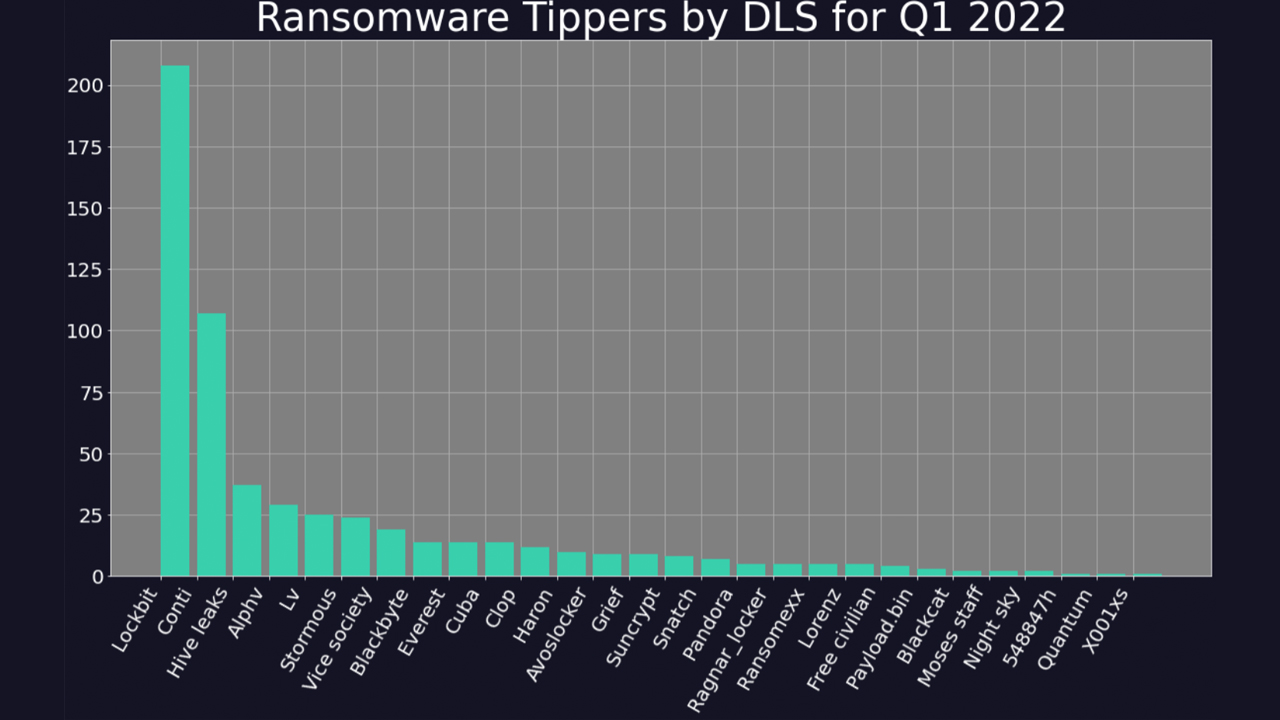Ransomware activity falls 25% in Q1 2022
The drop in ransomware has been attributed to larger ransomware gangs being less active compared to the end of 2021


The number of ransomware attacks dropped significantly during the first quarter of 2022, according to new research published this week.
Ransomware is still one of the biggest cyber security threats businesses are facing, but the number of organisations named in ransomware attacks has fallen 25.3% compared to Q4 2021.
A total of 582 organisations were named by ransomware groups on their sites this quarter, according to Digital Shadows, which conducted the research.
The security company said the decrease in activity can be attributed, in part, to a less prominent threat of larger ransomware groups so far this year.
Conti, one of the most prolific ransomware groups of recent years, was found to have claimed 31.8% fewer victims compared to the previous quarter. The PYSA group has so far listed no new corporate victims in 2022.
The same can’t be said for the operators of LockBit 2.0, though. The group has been highly active this year, claiming the majority of ransomware victims, Digital Shadows said.

Conti is still the second-most active group of the year, according to the security company’s data, with both it and LockBit 2.0 accounting for more than half of all ransomware success so far this year.
Sign up today and you will receive a free copy of our Future Focus 2025 report - the leading guidance on AI, cybersecurity and other IT challenges as per 700+ senior executives
Ransomware groups have also changed their strategy in recent months, as the national security agencies of the US, UK, and Australia have noted.
Cyber criminals are shifting away from the ‘big game hunting’ approach to ransomware after the double extortion model became popularised with attacks on larger businesses in 2020.
Ransomware groups are now shifting their focus to medium-sized companies after a string of high-profile attacks throughout 2021 led to heightened international pressure to disrupt and unearth ransomware groups like REvil, which was behind the supply chain attack on Kaseya.
Despite the first quarter of 2021 showing signs of a slower ransomware market, cyber criminals have been hard at work in other areas.
Conti’s lack of action could have been affected by a Ukrainian security researcher leaking the group’s tools and internal communications in retaliation for the group’s public support of Russia’s invasion of Ukraine.
The invasion has also spurred cyber attackers from across the world to help support the fight against Russia in cyber space. Distributed denial of service (DDoS) attacks are among the most common types of cyber attacks being launched against Russia, at the command of Ukraine’s IT Army.
Anonymous has also claimed to have successfully executed a number of attacks against Russia since the war started, including injecting footage from inside Ukraine to Russian television streams.
The LAPSUS$ hackers were among the most prominent cyber criminals of the year so far and were at first confused with a ransomware gang, but later analysis of its attacks showed the group operated on a pure extortion model.

Connor Jones has been at the forefront of global cyber security news coverage for the past few years, breaking developments on major stories such as LockBit’s ransomware attack on Royal Mail International, and many others. He has also made sporadic appearances on the ITPro Podcast discussing topics from home desk setups all the way to hacking systems using prosthetic limbs. He has a master’s degree in Magazine Journalism from the University of Sheffield, and has previously written for the likes of Red Bull Esports and UNILAD tech during his career that started in 2015.
-
 Gender diversity improvements could be the key to tackling the UK's AI skills shortage
Gender diversity improvements could be the key to tackling the UK's AI skills shortageNews Encouraging more women to pursue tech careers could plug huge gaps in the AI workforce
-
 Researchers claim Salt Typhoon masterminds learned their trade at Cisco Network Academy
Researchers claim Salt Typhoon masterminds learned their trade at Cisco Network AcademyNews The Salt Typhoon hacker group has targeted telecoms operators and US National Guard networks in recent years
-
 15-year-old revealed as key player in Scattered LAPSUS$ Hunters
15-year-old revealed as key player in Scattered LAPSUS$ HuntersNews 'Rey' says he's trying to leave Scattered LAPSUS$ Hunters and is prepared to cooperate with law enforcement
-
 The Scattered Lapsus$ Hunters group is targeting Zendesk customers – here’s what you need to know
The Scattered Lapsus$ Hunters group is targeting Zendesk customers – here’s what you need to knowNews The group appears to be infecting support and help-desk personnel with remote access trojans and other forms of malware
-
 Impact of Asahi cyber attack laid bare as company confirms 1.5 million customers exposed
Impact of Asahi cyber attack laid bare as company confirms 1.5 million customers exposedNews No ransom has been paid, said president and group CEO Atsushi Katsuki, and the company is restoring its systems
-
 The US, UK, and Australia just imposed sanctions on a Russian cyber crime group – 'we are exposing their dark networks and going after those responsible'
The US, UK, and Australia just imposed sanctions on a Russian cyber crime group – 'we are exposing their dark networks and going after those responsible'News Media Land offers 'bulletproof' hosting services used for ransomware and DDoS attacks around the world
-
 A notorious ransomware group is spreading fake Microsoft Teams ads to snare victims
A notorious ransomware group is spreading fake Microsoft Teams ads to snare victimsNews The Rhysida ransomware group is leveraging Trusted Signing from Microsoft to lend plausibility to its activities
-
 Volkswagen confirms security ‘incident’ amid ransomware breach claims
Volkswagen confirms security ‘incident’ amid ransomware breach claimsNews Volkswagen has confirmed a security "incident" has occurred, but insists no IT systems have been compromised.
-
 The number of ransomware groups rockets as new, smaller players emerge
The number of ransomware groups rockets as new, smaller players emergeNews The good news is that the number of victims remains steady
-
 Teens arrested over nursery chain Kido hack
Teens arrested over nursery chain Kido hacknews The ransom attack caused widespread shock when the hackers published children's personal data